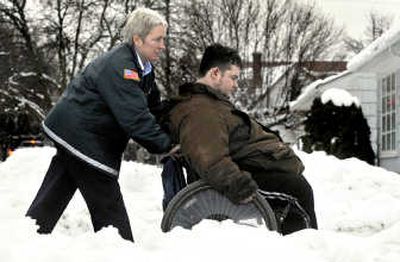Wheelchair users suffer through snow

As long as snow’s on the ground, getting around will be a challenge for Shelly Mitchell.
After the last storm earlier this month, Mitchell requested a Spokane Transit Authority Paratransit van so she could run errands. But when the van arrived, the snow hadn’t been shoveled out front of her apartment building in Cheney.
So the 34-year-old woman, who uses a wheelchair, missed her ride.
“Sometimes just getting out your apartment door is challenging,” said Mitchell, who was disabled by injuries after a fire nearly six years ago. “I was going to go to Wal-Mart and get my hair cut and pick up a few things for my service animal.”
For many who use wheelchairs, there’s no worse time than winter for mobility.
Snow mounds become obstacles. Slick sidewalks can bring chairs to a halt, their wheels spinning. And the conditions can mean days of missed appointments and trips – even to the grocery store – canceled.
Many wheelchair users say if it weren’t for STA’s Paratransit – which helps qualified people with disabilities get around – their mobility situation would be more dire. For many, it’s the only way to get around in the winter. But, at times, not even that program can guarantee transportation.
STA van drivers won’t pick up riders if access to their doors isn’t clear.
“If the walk is cleared and accessible, then we will go to the door,” said Molly Myers, STA spokeswoman. “But if the walk is not cleared, they will not take the client to the door” or pick them up. “It’s just too much of a hardship and a liability for us.”
Otherwise, the STA program offers scheduled rides and door-to-door service.
Mitchell understands the STA guidelines. She’s more frustrated that she can’t control whether there is access to her door. “I was isolated,” she said.
The manager of her apartment complex shovels the sidewalks and parking lot, “but there’s no set time,” Mitchell said.
Last week, when she couldn’t get beyond her front door, Mitchell staged a protest: She put her stereo on her wheelchair and blared Twisted Sister’s “We’re Not Gonna Take It.” She also replayed 30-year-old broadcasts from when people with disabilities took over the federal building in San Francisco, which helped prompt the Americans with Disabilities Act.
Then she called the state’s Fair Housing Alliance, which faxed a letter to her apartment manager saying the law requires snow to be cleared. The walks have since been shoveled.
Once a wheelchair user gets out of the house, getting around can still be a challenge. Curbs are hidden and “you can’t see where the sidewalk ends,” Mitchell said.
“It’s always a crapshoot when you go out in weather like this,” said Muriah Barela, 30. “When you are disabled, you have to pick where and when you want to go, just like anyone else. A wheelchair is like a car in miniature.”
Transportation is the No. 1 challenge, Dianne Lennard said. “You can get it, but you have to wait for rides.”
Lennard, 50, uses STA Paratransit to get to work, and when there’s no snow she can get to a nearby grocery store in her wheelchair.
But during wintry conditions, “even if I lived a block from the store I couldn’t go,” Lennard said. “I would get stuck since the sidewalks aren’t cleared or safe. Also, it’s hard to get up on the sidewalks if it’s all plugged up with snow.”
Crossing streets can be dangerous.
Lennard, who has used a wheelchair all her life, got stuck in a pothole two years ago while trying to cross Hartson Avenue. She was hit by a car and broke her collarbone in the fall. “You can’t move fast enough to get across because of the snow,” Lennard said. “It’s too slick.”
Barela, Lennard and Mitchell said getting around their neighborhoods is impossible after heavy snowfall because not everyone clears the sidewalks.
“A lot of people think (being able to get around) is special rights for disability,” Mitchell said, “but it’s about just being able to cross the street like everyone else.
“It’s nothing about being special.”